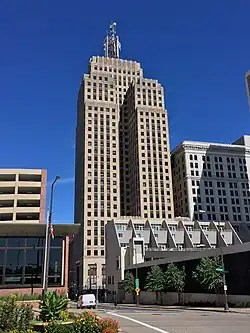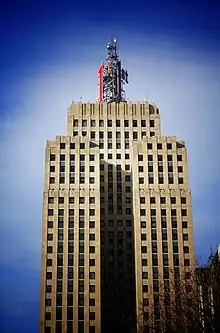| First National Bank Building | |
|---|---|
 First National Bank Building | |
| General information | |
| Status | Completed |
| Location | 332 Minnesota Street, Saint Paul, Minnesota |
| Coordinates | 44°56′48″N 93°05′28″W / 44.946711°N 93.091064°W |
| Completed | 1931 |
| Height | |
| Roof | 417 ft (127 m) |
| Technical details | |
| Floor count | 32 |
| Floor area | 528,185 sq ft (49,070.0 m2)[1] |
| Design and construction | |
| Architect(s) | Graham, Anderson, Probst & White[2] |
The First National Bank Building is a 417-foot-tall high-rise building in downtown Saint Paul, Minnesota, United States.[3][4] The building has the tallest connecting skyway in the Twin Cities.
Construction
The first building on the property, the Merchants Bank Building, was built in 1915 and opened in 1916.[5] Rising 228 feet tall and with 16 stories, the building was the tallest in Saint Paul until it was overtaken by the Wells Fargo Place.[6][7] The First National Bank Building was designed by Graham, Anderson, Probst & White in 1931 after Merchants National Bank was absorbed by First National Bank.[8] The 32 story structure struggled to acquire materials in 1930 due to the construction of the Empire State Building at the same time.[9] In 1932 the cost of the building was $3,340,185.44.[10]
Building
Skyway

It is believed that the world's first modern skyway was built to connect the two towers.[9] The skyway connects the building's 17th floor with the adjacent 16-story Merchants Bank Building which is part of the same property. It is the tallest skyway in the Twin Cities.[5] The skyway with six tinted windows was built in 1931 in conjunction of the finishing of the building. The Merchants Bank Building was the tallest in Saint Paul from 1915 to 1931 when the First National Bank Building overtook it.[11]
Sign
The building is probably most known for the large neon red "1st" sign atop the building. The sign has three sides and rises four stories to a height of fifty feet.[8][12] In 1973 the sign was turned off in response to the energy crisis. The sign was relighted ten years later after a major renovation. The original "vermillion vitreous porcelain edged [sign] with a double row of red neon tubes" was replaced with solely red tubes. Around four thousand feet of neon tubing was used in the renovation.[10] The sign can be seen from almost 75 miles away from the air at night and 20 miles away on a clear day.[13]

After renovation in 2016 due to wind damage, the sign was relit, with a color changing LED sign. For the Winter Carnival in 2017, the sign changed color from neon red to icy blue.[14] In 2017, the sign was changed to purple, during the first anniversary of musician Prince's death.
Building
An addition to the north was constructed in 1971, designed by Haarstick, Lundgren & Assoc.[2]
The building is eligible for the National Register of Historic Places but not currently listed. The building's overall design is Art Deco.[15] The building was the tallest in Saint Paul from its construction in 1931 till 1986 when Galtier Plaza (now Cray Plaza) overtook the building, a total of 55 years. The building is currently the third tallest in Saint Paul behind Jackson Tower of Cray Plaza and Wells Fargo Place (formerly the Minnesota World Trade Center).[16]
The building was sold in January 2007 to First National Building Holdings for an undisclosed amount. The building was then sold in 2012 to an unknown organization. Three years later the building was sold to Madison Equities of St. Paul.[9][17][18] [19]
See also
References
- ↑ "First National Bank Building". Skyscraper Center. CTBUH. Retrieved July 31, 2017.
- 1 2 Minnesota Modern Registry, Docomomo US MN, accessed April 17, 2023.
- ↑ "First National Bank Building" Emporis. Retrieved on September 11, 2008
- ↑ "First National Bank Building" Skyscraperpage.com
- 1 2 Millett, Larry (2007). AIA Guide to the Twin Cities: The Essential Source on the Architecture of Minneapolis and St. Paul. Minnesota Historical Society Press. p. 324. ISBN 978-0-87351-540-5.
- ↑ Merchants Bank Building SkyscraperPage.com
- ↑ Merchant's Bank Building Emporis.
- 1 2 Hess, Jeffrey A.; Clifford Larson (2006). St. Paul's Architecture: A History. Minneapolis, Minnesota: University of Minnesota Press. p. 161. ISBN 0-8166-3590-0.
- 1 2 3 Wilcoxen, William (November 25, 2005) "Tough times for the beacon of St. Paul" Minnesota Public Radio
- 1 2 Chappell, Kitt; Sally, A. (1992). Architecture and planning of Graham, Anderson, Probst, and White, 1912–1936. Chicago: University of Chicago Press. pp. 241–243. ISBN 0-226-10134-7. OCLC 23212354.
- ↑ Soenarie, Angelique (April 11, 2004), "What is it? – It looks familiar but ..." Saint Paul Pioneer Press
- ↑ "Best Use Of Neon Lighting Archived September 21, 2008, at the Wayback Machine" City Pages
- ↑ "First National Bank Building Archived September 25, 2008, at the Wayback Machine" CapitolRiver District Council.
- ↑ "1st National Bank sign shines a new color for 1st time". Retrieved March 4, 2017.
- ↑ Yuen, Laura (September 9, 2005) "Iconic sign may get company – Anchor Bank plan lights up some foes", Saint Paul Pioneer Press
- ↑ "St. Paul Skyscraper Diagram" SkyscraperPage.com
- ↑ Wyant, Carissa (January 23, 2007) "St. Paul's First National Bank building sold" Minneapolis / St. Paul Business Journal
- ↑ Gilyard, Buryl (September 20, 2012) [Burl Gilyard]
- ↑ Painter, Kristen (November 2, 2015) [Kristen Painter]